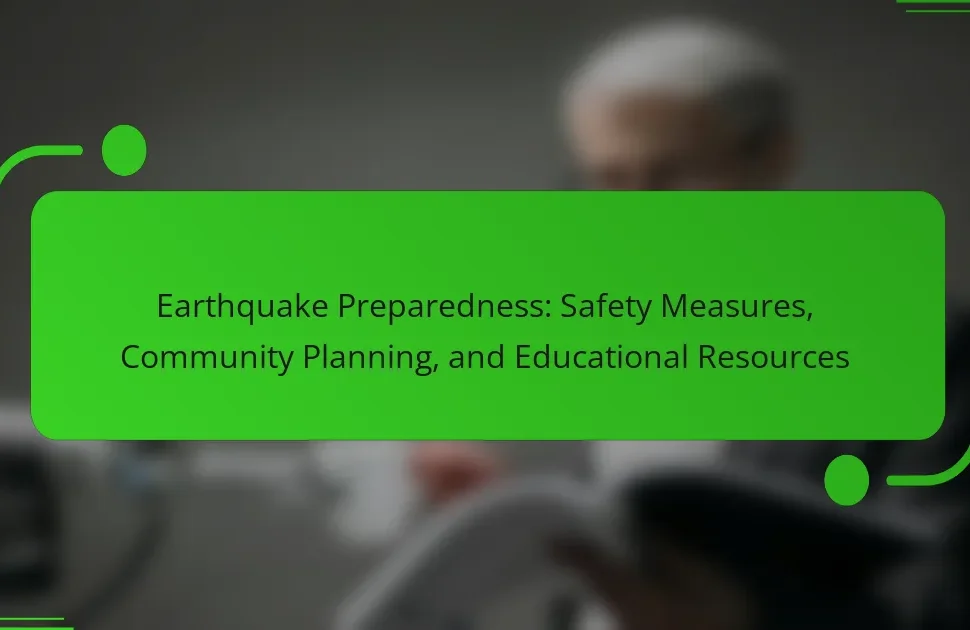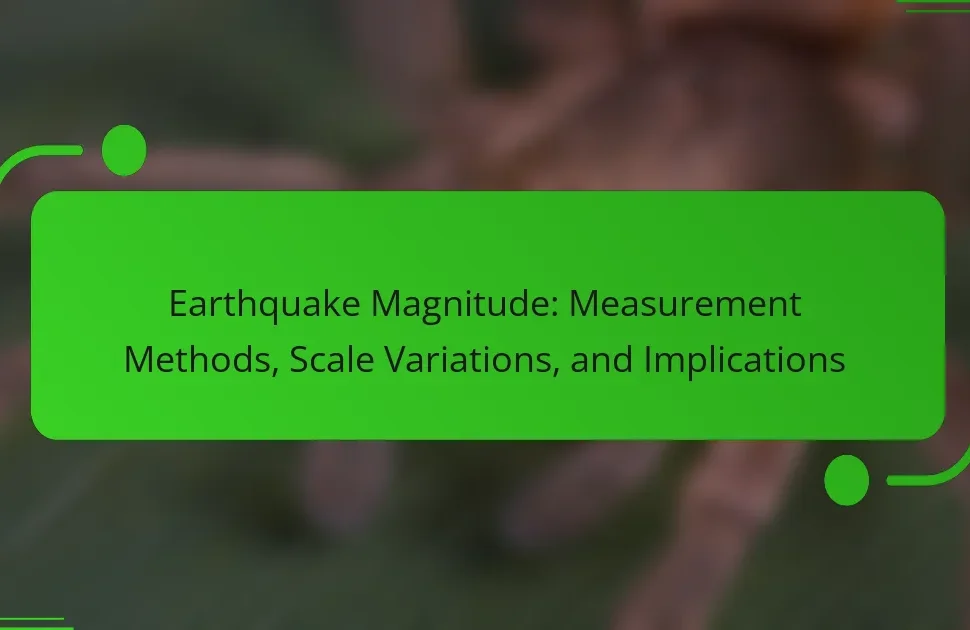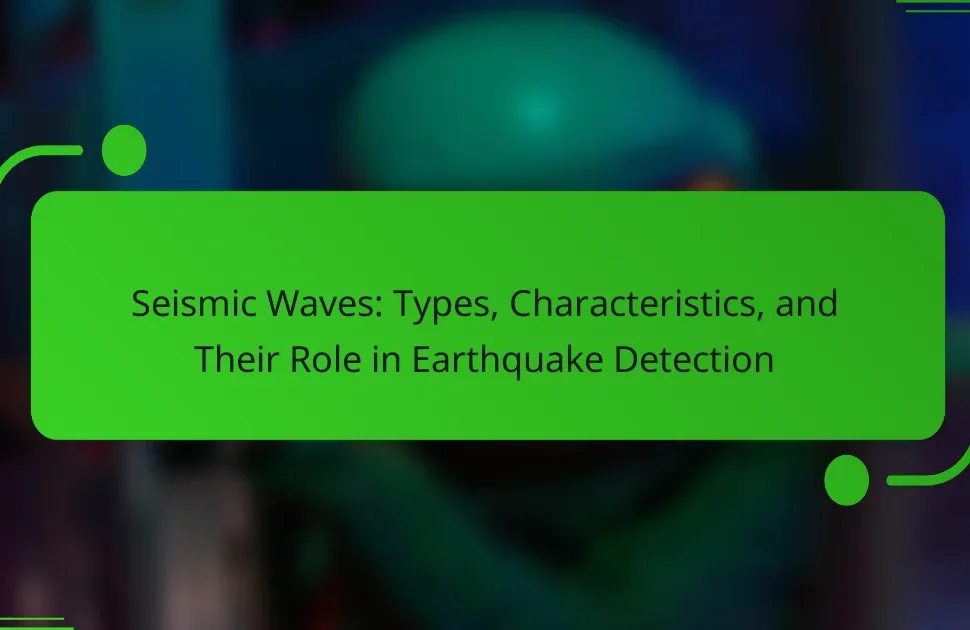Aftershock patterns refer to the sequences of seismic events that follow a significant earthquake, typically occurring in the same region as the main shock. These aftershocks vary in magnitude and frequency, diminishing over time according to the Omori law, which states that their occurrence decreases as time progresses post-event. The article explores the characteristics of aftershock patterns, including their frequency, magnitude, and spatial distribution, emphasizing their importance in assessing ongoing seismic risk. Additionally, it highlights how understanding these patterns can enhance earthquake preparedness and response, improve resource allocation, and inform construction practices to mitigate potential damage.

What are Aftershock Patterns?
Aftershock patterns are sequences of seismic events that follow a significant earthquake. They typically occur in the same region as the main shock. Aftershocks can vary in magnitude and frequency. Their occurrence diminishes over time, following a general trend. The rate of aftershock occurrence is often modeled using the Omori law. This law states that the frequency of aftershocks decreases with time after the main shock. Research has shown that aftershocks can continue for days, weeks, or even years. Understanding aftershock patterns is crucial for assessing ongoing seismic risk.
How do Aftershock Patterns develop after a major earthquake?
Aftershock patterns develop as a result of the stress redistribution in the Earth’s crust following a major earthquake. When a significant seismic event occurs, it alters the stress along fault lines. This change in stress can trigger smaller earthquakes, known as aftershocks. Aftershocks typically occur in the same general area as the main shock. They can continue for days, weeks, or even months after the initial event. Statistical models show that the frequency and magnitude of aftershocks decrease over time. For instance, the Gutenberg-Richter law describes how the number of aftershocks diminishes as their magnitude decreases. This pattern is observed in many major earthquakes, providing insights into aftershock behavior.
What factors influence the occurrence of aftershocks?
The occurrence of aftershocks is influenced by several factors. The magnitude of the mainshock is a significant factor; larger earthquakes typically produce more numerous and stronger aftershocks. The geological conditions of the area also play a crucial role. Regions with complex fault systems may experience different aftershock patterns compared to simpler geological settings. Time since the mainshock affects aftershock frequency; they tend to decrease in occurrence over time. The stress changes in the Earth’s crust caused by the mainshock can trigger aftershocks in surrounding areas. Historical data shows that aftershock sequences can vary widely based on these factors, with some events producing aftershocks for years, while others may cease within days.
What is the relationship between the main shock and aftershock patterns?
The main shock and aftershock patterns are closely related in seismology. The main shock is the largest earthquake event in a sequence, while aftershocks are smaller earthquakes that follow. Aftershocks typically occur in the same general area as the main shock. Their frequency and magnitude generally decrease over time.
Research indicates that aftershock activity can last for days, months, or even years after the main shock. The relationship is often described by the Omori-Utsu law, which quantifies the decay of aftershock frequency over time. This law shows that aftershock rates decrease rapidly initially and then more slowly over time.
Statistical analyses of historical earthquake data support the correlation between main shocks and aftershock occurrences. For instance, studies have shown that aftershock magnitudes are often proportional to the main shock’s magnitude. This relationship is essential for understanding seismic hazard assessments and improving predictive models.
Why is it important to study Aftershock Patterns?
Studying aftershock patterns is crucial for improving earthquake preparedness and response. Aftershocks can significantly impact affected areas following a major earthquake. Understanding these patterns helps scientists predict the likelihood and timing of aftershocks. This knowledge can inform evacuation plans and resource allocation. Research shows that aftershocks can occur days, weeks, or even months after the main event. For example, the 1994 Northridge earthquake had numerous aftershocks that caused additional damage. By analyzing historical data, researchers can develop predictive models to anticipate aftershock activity. This can ultimately save lives and reduce economic losses in earthquake-prone regions.
How do Aftershock Patterns impact communities and infrastructure?
Aftershock patterns significantly impact communities and infrastructure by causing additional damage following a primary earthquake. These aftershocks can lead to structural failures in buildings that were already compromised. Communities may experience increased anxiety and disruption due to the uncertainty of aftershock occurrences. Infrastructure such as roads and bridges may suffer from repeated stress, leading to potential failures. Studies show that aftershocks can occur days, weeks, or even months after the main event, complicating recovery efforts. For example, the 2010 Haiti earthquake had numerous aftershocks that hindered rescue operations and rebuilding efforts. Additionally, aftershock patterns can influence emergency response strategies and resource allocation in affected areas.
What role does understanding Aftershock Patterns play in disaster preparedness?
Understanding aftershock patterns is crucial for disaster preparedness. Aftershocks can occur days, weeks, or even months after a major earthquake. They can lead to additional damage to already weakened structures. Recognizing these patterns helps in assessing the risk of subsequent tremors. This knowledge allows emergency services to prioritize response efforts effectively. Studies show that aftershocks are often predictable based on the initial quake’s magnitude and location. For example, the 2010 Haiti earthquake had significant aftershocks that impacted recovery efforts. Preparedness plans can be improved by integrating aftershock data into risk assessments. This proactive approach enhances community resilience in the aftermath of major seismic events.

What are the key attributes of Aftershock Patterns?
Aftershock patterns are characterized by their frequency, magnitude, and spatial distribution. The frequency of aftershocks typically decreases over time following a main earthquake event. Magnitude refers to the strength of aftershocks, which are generally smaller than the initial quake. Spatial distribution indicates how aftershocks are clustered in relation to the main shock’s epicenter. Research shows that aftershocks often occur within a defined area surrounding the original earthquake. These patterns help in understanding seismic activity and predicting future aftershocks. Studies have utilized statistical models to analyze these attributes effectively.
How is the duration of aftershocks determined?
The duration of aftershocks is determined by several factors, including the magnitude of the main earthquake and the geological conditions of the area. Larger earthquakes typically produce longer-lasting aftershocks. Research shows that aftershocks can continue for days, weeks, or even months following the main event. The decay rate of aftershocks often follows a statistical pattern known as the Omori law. This law indicates that the frequency of aftershocks decreases over time. Additionally, the specific geological characteristics, such as fault lines and rock types, can influence aftershock duration. Studies in seismology provide data supporting these patterns, demonstrating the relationship between mainshock size and aftershock activity.
What is the typical duration range for aftershocks?
Aftershocks typically last from a few seconds to several minutes. The duration can vary based on the magnitude of the main earthquake. Generally, larger earthquakes produce longer aftershocks. Research shows that aftershocks can continue for days, weeks, or even months following the initial quake. The frequency and intensity of aftershocks tend to decrease over time. Studies indicate that aftershocks are most common in the first few days after the main event.
How does the magnitude of the main shock affect aftershock duration?
The magnitude of the main shock directly influences aftershock duration. Larger main shocks typically produce longer aftershock sequences. This is due to the increased energy release and stress changes in the Earth’s crust. For example, a magnitude 7.0 earthquake may generate aftershocks lasting weeks to months. In contrast, a magnitude 5.0 event usually results in shorter aftershock durations, often just days. Research has shown that aftershocks can decrease in frequency and intensity over time, but larger shocks result in a more prolonged aftershock activity. Studies indicate that the scaling relationship between main shock magnitude and aftershock duration is well-documented in seismology.
What predictive models are used to analyze Aftershock Patterns?
Predictive models used to analyze aftershock patterns include the Omori-Utsu law, the Epidemic Type Aftershock Sequence (ETAS) model, and the Coulomb failure stress model. The Omori-Utsu law describes the decay of aftershock frequency over time. This model is based on empirical observations from numerous seismic events. The ETAS model incorporates the triggering of aftershocks by previous shocks, accounting for spatial and temporal clustering. It has been validated through extensive data analysis of seismic sequences. The Coulomb failure stress model evaluates changes in stress on fault lines due to mainshock events. This model helps predict aftershock locations and magnitudes based on physical principles of fault mechanics. Each model contributes to understanding aftershock behavior and improving earthquake preparedness.
How do statistical models forecast aftershock activity?
Statistical models forecast aftershock activity by analyzing past earthquake data. These models utilize historical patterns of aftershocks to predict future occurrences. They often apply statistical techniques such as the Omori-Utsu law, which describes the decay of aftershock frequency over time. This law indicates that aftershocks are more frequent shortly after the main shock and decrease in frequency over time.
Additionally, models may incorporate parameters like the magnitude of the main shock and the geological characteristics of the region. Research has shown that larger main shocks tend to produce more intense aftershock sequences. For example, a study published in the journal “Nature” by Helmstetter and Sornette (2002) demonstrated the effectiveness of statistical models in predicting aftershock sequences.
These models help seismologists provide valuable forecasts that can inform public safety measures.
What are the limitations of current predictive models for aftershocks?
Current predictive models for aftershocks have several limitations. They often rely on historical data, which may not accurately represent future seismic activity. Many models do not account for complex geological factors that influence aftershock occurrence. Additionally, these models typically assume that aftershock patterns follow a specific statistical distribution, which may not hold true in all cases. The lack of real-time data integration limits their effectiveness in dynamic situations. Furthermore, many models struggle to predict the timing and magnitude of aftershocks accurately. Research shows that models can underestimate the probability of large aftershocks following significant earthquakes. These limitations hinder the ability to provide reliable forecasts for aftershock events.

How can we apply knowledge of Aftershock Patterns in real-world scenarios?
Understanding aftershock patterns can enhance earthquake preparedness and response. By analyzing historical aftershock data, emergency management agencies can better predict aftershock occurrences. This knowledge allows for improved resource allocation during recovery efforts. For instance, the 2010 Haiti earthquake demonstrated the need for ongoing assessments post-event. Studies show that aftershocks can persist for weeks or months, influencing evacuation strategies. Additionally, construction practices can be adapted to minimize damage from potential aftershocks. Implementing early warning systems based on aftershock patterns can save lives. Overall, applying this knowledge leads to more resilient communities in seismically active regions.
What best practices can communities implement based on Aftershock Patterns?
Communities can implement several best practices based on Aftershock Patterns. First, they should establish comprehensive monitoring systems to track seismic activity. This allows for timely alerts and preparedness measures. Second, communities can develop educational programs on earthquake safety and aftershock preparedness. These programs can inform residents about the patterns and risks of aftershocks. Third, communities should create and regularly update emergency response plans. These plans must include specific protocols for aftershocks, which can occur minutes to weeks after the initial quake. Fourth, engaging with local experts to analyze historical aftershock data can enhance understanding and response strategies. This evidence-based approach helps communities anticipate and mitigate risks effectively. Lastly, fostering community resilience through drills and simulations can prepare residents for potential aftershock scenarios. These practices collectively enhance community safety and preparedness in the face of seismic events.
How can building codes be adjusted to account for aftershock risks?
Building codes can be adjusted to account for aftershock risks by incorporating specific design criteria. These criteria include enhanced structural integrity to withstand additional seismic forces. Codes can mandate the use of materials that provide better flexibility and ductility during aftershocks.
Additionally, building codes can require safety factors that exceed standard seismic design provisions. This adjustment ensures structures can endure multiple seismic events. Codes can also include guidelines for retrofitting existing buildings to improve resilience against aftershocks.
Furthermore, local geological assessments can inform code modifications based on historical aftershock data. This data helps identify regions with higher aftershock frequencies. Integrating such assessments into building codes enhances the overall safety of structures in earthquake-prone areas.
What educational resources are available for public awareness of aftershocks?
Educational resources for public awareness of aftershocks include government websites and educational institutions. The United States Geological Survey (USGS) provides comprehensive information on aftershocks. Their resources include educational articles, infographics, and earthquake preparedness guides. Local emergency management agencies also offer workshops and seminars. Universities often conduct public lectures and distribute research findings on seismic activity. Nonprofit organizations, like the Earthquake Engineering Research Institute, provide outreach programs. These resources aim to educate the public about the risks and safety measures related to aftershocks.
How can technology enhance our understanding of Aftershock Patterns?
Technology enhances our understanding of aftershock patterns through advanced data analysis and modeling techniques. Seismologists utilize machine learning algorithms to analyze seismic data more efficiently. These algorithms can identify patterns in aftershock sequences that traditional methods may miss. Real-time data collection from seismic sensors improves the accuracy of aftershock predictions. Geographic Information Systems (GIS) visualize aftershock distributions effectively. High-performance computing allows for complex simulations of aftershock behavior under various conditions. Studies, such as those published in the Journal of Geophysical Research, demonstrate how these technologies lead to better predictive models and risk assessments.
What tools and software are used in the analysis of aftershock data?
Seismologists use various tools and software for analyzing aftershock data. Commonly used software includes SeisComP, which processes seismic data in real-time. Another tool is the Earthquake Research Institute’s software, which aids in aftershock prediction. Additionally, MATLAB is frequently utilized for data analysis and visualization. Open-source tools like ObsPy are also popular among researchers. These tools help in modeling aftershock sequences and understanding their patterns. The effectiveness of these tools is supported by numerous studies in seismology, demonstrating their application in real-world scenarios.
How can machine learning improve predictive models for aftershocks?
Machine learning can enhance predictive models for aftershocks by analyzing large datasets of seismic activity. It identifies patterns and correlations that traditional methods may overlook. Algorithms can process real-time data to improve accuracy in forecasting. Machine learning models adapt as new data becomes available, refining predictions over time. Studies have shown that machine learning approaches can outperform classical statistical models in predicting aftershock occurrences. For instance, a study published in the journal “Nature” demonstrated that machine learning could predict aftershock probabilities with improved precision. By leveraging complex features from seismic data, these models provide valuable insights for disaster preparedness and risk management.
Aftershock patterns are sequences of seismic events that follow a significant earthquake, characterized by their frequency, magnitude, and spatial distribution. The article explores how these patterns develop due to stress redistribution in the Earth’s crust, the factors influencing aftershock occurrence, and the relationship between main shocks and aftershocks. It also examines the importance of studying aftershock patterns for disaster preparedness, the predictive models used to analyze aftershocks, and their impact on communities and infrastructure. Key attributes such as duration and the influence of the main shock’s magnitude on aftershocks are discussed, along with best practices for enhancing community resilience and safety in earthquake-prone regions.




